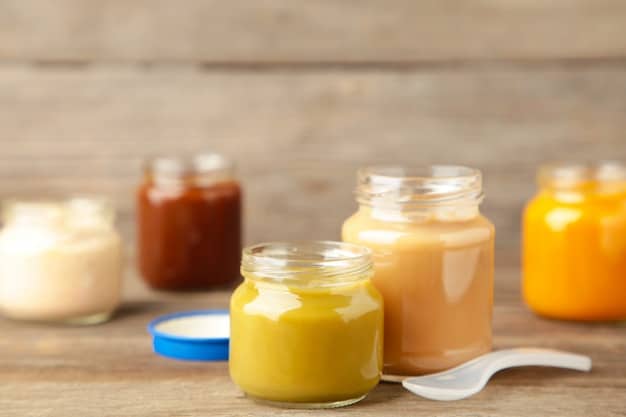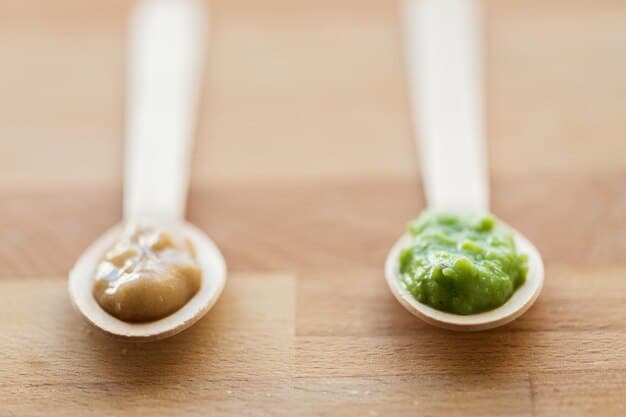Organic vs. Non-Organic Baby Food: 2025’s Truth & Trends

The Truth About Organic vs. Non-Organic Baby Food: A 2025 Comparison reveals the key differences in nutritional value, safety, and environmental impact, helping parents make informed decisions for their baby’s health in the evolving food landscape.
Choosing the right food for your baby can feel overwhelming, especially with so many options available. One of the biggest debates is between organic vs. non-organic baby food. As we move into 2025, understanding the nuances of each choice is more important than ever.

Understanding “Organic” Baby Food
Organic food seems to be everywhere, but what does “organic” even mean? When it comes to baby food, the organic label is more than just a marketing term; it’s a set of standards and guidelines.
Understanding these standards is key to making informed choices.
What the Organic Label Means
The “organic” label on baby food signifies that the ingredients have been grown and processed following specific guidelines set by organizations like the USDA (United States Department of Agriculture).
These guidelines are designed to minimize exposure to synthetic pesticides, herbicides, and genetically modified organisms (GMOs).
- Limited Pesticide Use: Organic farming restricts the use of synthetic pesticides, which can be harmful to a baby’s developing system.
- Non-GMO: Organic baby foods cannot contain genetically modified ingredients, ensuring a more natural source of nutrition.
- Soil Health: Organic farming practices focus on maintaining and improving soil health, which can enhance the nutrient content of the crops.

Potential Benefits
Choosing organic baby food may come with some potential advantages for your little one.
While research is ongoing, some studies suggest possible benefits in terms of reduced pesticide exposure and increased nutrient density.
- Reduced Pesticide Exposure: Organic baby food aims to minimize your baby’s exposure to harmful pesticides, which can be particularly important during early development.
- Nutrient Density: Some research indicates that organic foods may have higher levels of certain nutrients, such as antioxidants, compared to conventionally grown options.
- Environmental Impact: Organic farming practices are often more environmentally friendly, contributing to soil health and biodiversity.
In summary, “organic” baby food adheres to strict guidelines regarding pesticide use, GMOs, and soil health. This may lead to reduced pesticide exposure, potentially higher nutrient density, and a positive environmental impact, but further research is always ongoing to confirm these benefits.
Exploring Non-Organic Baby Food
Non-organic baby food, often referred to as conventional baby food, doesn’t adhere to the same strict standards as its organic counterpart, but is this necessarily a bad thing? Understanding what it entails is essential.
There are benefits to non-organic options that are worth considering.
What Non-Organic Entails
Non-organic baby food is produced using conventional farming methods, which may involve the use of synthetic pesticides, herbicides, and GMOs. While this might sound alarming, it’s important to note that these products are still subject to safety regulations.
These regulations ensure that pesticide levels are within safe limits for consumption.
- Pesticide Use
- GMOs
- Cost Savings
Potential Benefits
Even though non-organic baby food doesn’t have the “organic” label, it has its own set of advantages.
One of the biggest is affordability. Non-organic baby food is usually more budget-friendly, making it accessible to more families.
- Affordability: As mentioned, non-organic baby food is typically more affordable, making it a viable option for families on a budget.
- Accessibility: Non-organic options are widely available in most supermarkets and grocery stores, making it convenient for parents to find what they need.
- Nutritional Value: Non-organic baby food is still required to meet nutritional standards, ensuring that it provides essential vitamins and minerals for your baby’s growth.
In short, non-organic baby food uses conventional farming methods, which may involve synthetic pesticides and GMOs, but it remains subject to strict safety regulations. The main benefits include affordability, accessibility, and adherence to essential nutritional standards, making it a practical choice for many families.
Nutritional Differences: Organic vs. Non-Organic
One of the biggest concerns for parents is the nutritional content of baby food. Are there significant differences between organic and non-organic options?
Let’s take a closer look at what the science says.
Vitamins and Minerals
When it comes to essential vitamins and minerals, both organic and non-organic baby foods must meet specific nutritional standards. These standards are designed to ensure babies get the nutrients they need for healthy development.
This means that you can generally expect similar levels of key nutrients in both types of baby food.
Pesticide Residue
One of the main concerns surrounding non-organic food is the presence of pesticide residues. While both organic and non-organic foods are tested for pesticides, organic foods, by definition, use fewer synthetic pesticides.
This means that organic options are less likely to contain detectable levels of pesticide residues.
Antioxidants and Phytonutrients
Some studies suggest that organic foods may contain higher levels of antioxidants and phytonutrients compared to non-organic options. These compounds are known for their health-promoting properties, such as reducing inflammation and supporting immune function.
However, the differences in antioxidant levels can vary depending on the specific crop and growing conditions.
In conclusion, when it comes to the nutritional value of organic vs. non-organic baby food, both options are fairly similar in terms of essential vitamins and minerals. Organic foods may have lower pesticide residues and potentially higher levels of antioxidants, but further research is always ongoing to confirm these observed health effects.
The Safety Factor: What Parents Need to Know
Safety is paramount when it comes to feeding our babies. Beyond nutrition, what are the key safety differences between organic and non-organic baby food?
Let’s see what the research reveals.
Pesticide Exposure
One of the primary safety concerns is pesticide exposure. Non-organic farming may involve synthetic pesticides, but regulatory bodies like the EPA (Environmental Protection Agency) set strict limits on pesticide residues in food.
The maximum residue levels (MRLs) are designed to ensure that pesticide levels are safe for consumption.
Contaminants and Additives
Both organic and non-organic baby foods are subject to regulations regarding contaminants and additives. Manufacturers are required to test for heavy metals, bacteria, and other potential contaminants to ensure product safety.
However, some parents prefer organic options because they eliminate the use of artificial colors, flavors, and preservatives.
Allergens
Whether you choose organic or non-organic baby food, it’s crucial to be mindful of potential allergens. Common allergenic foods include milk, eggs, peanuts, tree nuts, soy, wheat, fish, and shellfish.
Always read the ingredient labels carefully and introduce new foods one at a time to monitor for allergic reactions.
In summary, safety is a top priority when choosing baby food. While pesticide exposure is a valid concern, regulatory bodies set limits to ensure food safety. Both organic and non-organic options are subject to testing for contaminants, but organic foods avoid artificial additives. Always be mindful of potential allergens, regardless of whether you choose organic or non-organic options.
Cost Comparison: Balancing Budget and Choices
Let’s face it: raising a baby can be expensive. Considering the cost of baby food is a critical decision point for many families.
How do the prices of organic and non-organic baby food compare?
Price Differences
Generally speaking, organic baby food tends to be more expensive than non-organic alternatives. This is due to the higher costs associated with organic farming practices, such as avoiding synthetic pesticides and fertilizers.
The price difference can vary depending on the brand, product type, and store, but it’s not uncommon for organic options to be 20-50% more expensive.
Budget-Friendly Tips
If you want to feed your baby organic food without breaking the bank, there are several strategies you can try.
One option is to make your own baby food at home using organic fruits and vegetables. Another approach is to buy organic products in bulk or look for sales and discounts.
Long-Term Costs
When considering the cost of baby food, it’s also worth thinking about potential long-term health benefits. Some parents believe that investing in organic food reduces the risk of health issues associated with pesticide exposure.
It’s definitely something to factor into your long term considerations.
- Homemade Options: Making baby food at home using organic ingredients can be a very cost-effective strategy.
- Bulk Buying
- Coupons and Discounts
In brief, organic baby food is generally more expensive than non-organic options due to higher farming expenses. Parents can save money by making baby food at home, buying in bulk, or looking for discounts and coupons. When focusing on cost it’s worth consider the long term benefits.
Making the Right Choice for Your Family in 2025
Selecting the right baby food is a deeply personal decision. There’s no one-size-fits-all answer, and what works for one family could be a different solution for another.
Here are some final thoughts to help you make the best choice for you and your little one.
Personal Considerations
First and foremost, evaluate your family’s values, priorities, and budget. Do you have a strong preference for organic products and a willingness to pay more? Or are you primarily concerned with affordability and accessibility? Consider what matters most to you and make a decision that aligns with your goals.
It’s important to remember no matter the outcome, the goal is always a healthy and happy baby.
Consulting with Professionals
Don’t hesitate to seek guidance from healthcare professionals, such as pediatricians or registered dietitians. They can provide personalized recommendations based on your baby’s individual needs and any specific health concerns.
As always consult with a medical professional about any concerns.
Staying Informed
The world of baby food is constantly evolving. New research emerges, regulations change, and products come and go. Stay informed about the latest developments in nutrition and food safety to ensure you’re making the most up-to-date decision for your baby.
In conclusion, choosing between organic and non-organic baby food is a personal journey, influenced by your values, budget, and priorities. Consulting professionals and staying informed can help you make a decision that supports your baby’s health and well-being. When it comes to the health of your child, information is key.
| Key Point | Brief Description |
|---|---|
| 🌱 Organic Benefits | Fewer pesticides, possibly higher antioxidants. |
| 💰 Non-Organic Cost | Generally more affordable than organic options. |
| 🔬 Safety Standards | Both meet strict safety and nutritional guidelines. |
| 👪 Family Choice | Align with values, budget, and consult professionals. |
Frequently Asked Questions
▼
Both organic and non-organic baby foods have similar vitamin/mineral content. Some research suggests organic may contain slightly higher antioxidants, and it has fewer pesticides. Both provide necessary nutrients for growing babies.
▼
Consider making homemade baby food using fresh, organic ingredients to cut costs. Buying in bulk and keeping an eye out for discounts and coupons at your local grocery store are also good options.
▼
Yes, they are considered safe. Regulations ensure that pesticides are within safe limits and regularly tested. Non-organic foods also must meet specific nutritional standards to ensure the consumer has what they need.
▼
Consulting a pediatrician is recommended, especially if your baby has allergies or health concerns. It’s best to seek medical council for the best results when it comes to the growth of your baby.
▼
Introduce new foods one at a time, watching for allergic reactions. Read labels, consult a doctor, and make sure they are getting a well balanced diet for optimal growth during their infant years.
Conclusion
Making the choice between **organic vs. non-organic baby food** is a decision that lies with you. By staying informed about the latest data, consulting with professionals, and carefully considering your family’s needs and values, you can confidently provide your baby with the best possible start.





